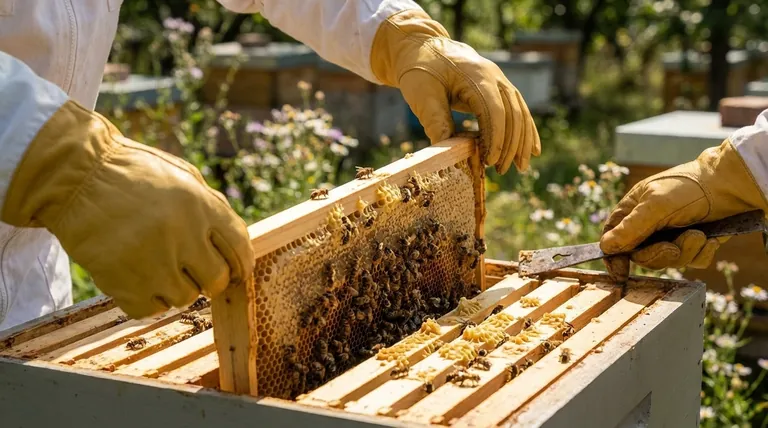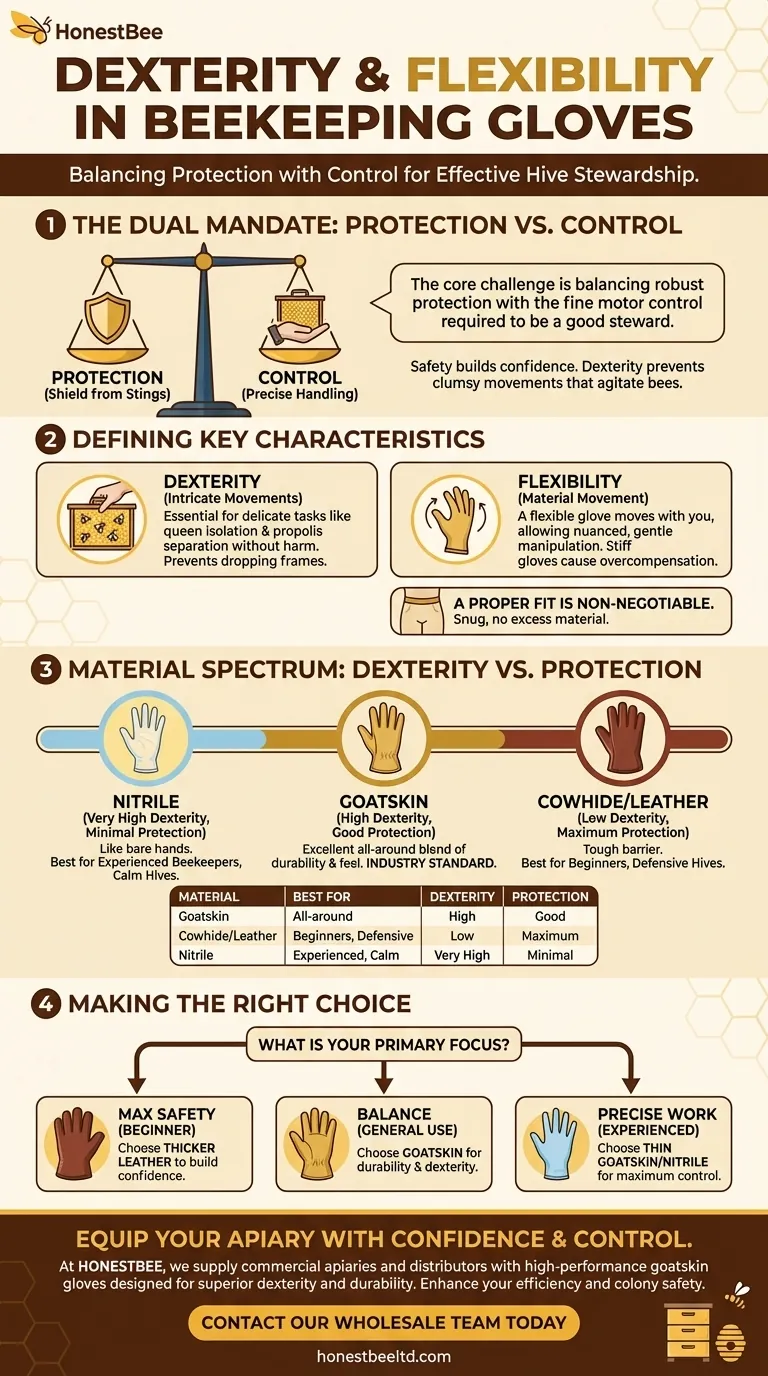In beekeeping, dexterity and flexibility are the critical bridge between protection and effective work. These qualities allow you to perform delicate tasks like handling frames, manipulating bees, and using tools without feeling restricted, ensuring the safety of both yourself and your colony.
The core challenge in selecting beekeeping gloves is not just about preventing stings, but about balancing robust protection with the fine motor control, or dexterity, required to be a good steward of your hive.

The Dual Mandate: Protection and Control
Beekeeping gloves serve two primary functions that are often in tension with one another: safeguarding your hands from stings while allowing you to interact with the hive's fragile environment precisely.
Why Protection is Foundational
Your first priority is safety. Protective gloves are essential for shielding your hands and arms from bee stings, which are not only painful but can be dangerous for those with allergies. This protection builds the confidence needed to work calmly and deliberately inside a hive.
Materials like thick leather or canvas offer the highest level of sting prevention, creating a tough barrier between you and the bees.
The Critical Need for Dexterity
Dexterity is your ability to perform intricate movements with your hands. In beekeeping, this means gently lifting a frame laden with honey and bees, isolating the queen without harming her, or deftly using a hive tool to separate propolis-sealed boxes.
Without good dexterity, your movements become clumsy. You risk dropping frames, squashing bees, or agitating the colony, which ironically increases the likelihood of stings.
How Flexibility Enables Gentle Handling
Flexibility refers to how easily the glove material moves with your hand. A flexible glove doesn't fight your movements, allowing for the gentle and nuanced manipulation required for hive inspections.
Stiff, inflexible gloves can make your hands feel trapped, leading to overcompensation and rougher handling of delicate hive components like wax comb.
Glove Characteristics That Define Performance
The material and fit of your gloves are the two most significant factors determining where they fall on the spectrum between pure protection and high dexterity.
Material Dictates Feel and Function
Different materials offer a distinct balance of qualities.
- Goatskin: Often considered the best all-around material, goatskin is thin and supple, providing excellent dexterity while still being durable enough to offer good sting protection.
- Cowhide/Leather: Thicker and more durable than goatskin, standard leather gloves offer maximum protection. This comes at the cost of significantly reduced flexibility and dexterity.
- Nitrile: These thin, disposable gloves offer the highest level of dexterity, almost like working bare-handed. They provide a minimal barrier to stings and are best used by experienced beekeepers with calm colonies.
The Importance of a Proper Fit
A proper fit is non-negotiable for control. Gloves should be snug but not tight, with no excess material at the fingertips that could get caught or obscure your sense of touch.
Poorly fitting gloves, even if made from a flexible material, will bunch up and severely limit your dexterity, negating the material's benefits.
Understanding the Trade-off: Dexterity vs. Protection
Choosing a glove is an exercise in managing trade-offs. There is no single "best" glove, only the best glove for a specific person and situation.
When to Prioritize Protection
Beginners are often best served by starting with thicker leather gloves. The confidence gained from superior protection allows you to learn the fundamentals of beekeeping without the constant fear of stings. These gloves are also useful when dealing with a particularly defensive or aggressive hive.
When to Prioritize Dexterity
As you gain experience and confidence, you will find that high dexterity becomes more valuable. Experienced beekeepers often prefer thinner goatskin or even nitrile gloves for routine inspections because it allows them to work more quickly, efficiently, and gently.
Making the Right Choice for Your Goal
Your choice of glove should be a conscious decision based on your experience level and the specific task at hand.
- If your primary focus is maximum safety as a beginner: Choose thicker leather gloves to build confidence and minimize stings while you learn.
- If your primary focus is precise, delicate work: Opt for thin goatskin or nitrile gloves to maximize your control and feel when handling frames and bees.
- If your primary focus is a balance of protection and control for general use: A well-fitting goatskin glove is the industry standard for its excellent blend of durability and dexterity.
Ultimately, the right glove empowers you to work with your bees confidently, gently, and effectively.
Summary Table:
| Glove Type | Best For | Dexterity Level | Protection Level |
|---|---|---|---|
| Goatskin | All-around use | High | Good |
| Cowhide/Leather | Beginners, defensive hives | Low | Maximum |
| Nitrile | Experienced beekeepers, calm hives | Very High | Minimal |
Equip your apiary with gloves that offer the perfect balance of protection and control. At HONESTBEE, we supply commercial apiaries and beekeeping equipment distributors with high-performance goatskin gloves and other essential supplies designed for durability and superior dexterity. Let us help you enhance your beekeeping efficiency and colony safety. Contact our wholesale team today to discuss your needs!
Visual Guide

Related Products
- Beekeeping Gloves Goatskin Leather with Long Cotton Sleeve for Beekeepers
- Goatskin Leather Beekeeper Gloves with Vent Long Sleeve for Beekeeping Honey Bee Sting Proof Protection
- Mesh Ventilated 3 Layer Goatskin Beekeepers Gloves for Beekeeping
- Goat Skin Leather Bee Sting Proof Beekeeping Gloves with Canvas Sleeve
- Professional Grade Foldable Beehive Handles
People Also Ask
- What are the arguments for and against using gloves in beekeeping? Balancing Protection and Dexterity
- What is the difference between cleaning cow leather and goat leather beekeeping gloves? Tailor Your Care for Longevity
- Why are protective gloves important in beekeeping? Boost Confidence & Safety in Your Apiary
- Why do some experienced beekeepers choose not to wear gloves? For Superior Dexterity & Hive Welfare
- What should beekeepers consider regarding the fit of beekeeping gloves? Achieve Safety and Dexterity



















